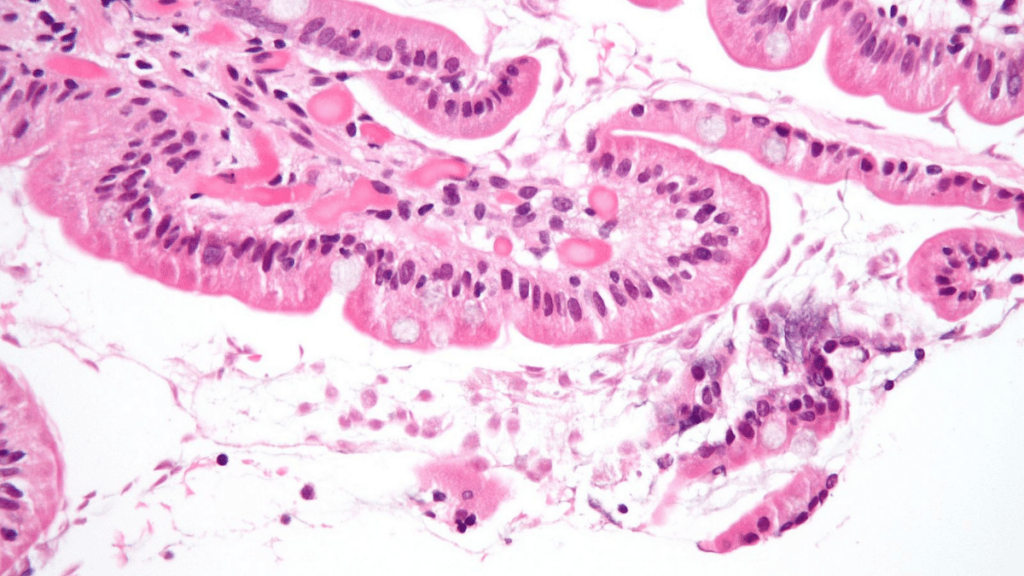You just got a new puppy, so your vet recommended testing a stool sample… and it came back positive for Giardia. Now what? Giardia isn’t one of the intestinal parasites that we typically think of (like hook worms and round worms) but it’s actually more common than you might think. In fact, we had several clients with pets that tested positive for Giardia this month alone! The affected pets weren’t just kittens and puppies, either. We treated quite a few adults dogs and cats as well. Some dogs and cats had been experiencing loose stools for a while, while other pets were entirely asymptomatic. Fortunately, Giardia is easily treatable! Here’s what you need to know…
What is Giardia, and how does infection occur?
Giardia intestinalis is a microscopic parasite found worldwide that infects the intestines of animals and humans. It is a single-celled protozoan that exists in two forms: the hardy cyst (infective) that can survive for months in water and damp environments, and the trophozoite (non-infective) which is the fragile feeding form. Coccidia, Cryptosporidia and Toxoplasma are examples of other protozoan parasites.
Cats and dogs become infected with Giardia after ingesting the cysts, which are usually found in infested water or stool, or by sniffing the cysts up from contaminated ground. Once the cysts are inside the body, they transform into the trophozoite and begin feeding off the intestinal wall. They reproduce, and some will eventually return back to the cyst form and be passed through the stool. Large numbers of feeding trophozoites are the cause of the primary symptom of a Giardia infection: soft, watery, foul-smelling stool, often with a greenish tinge and occasionally tinted with mucus or blood. Some pets will also experience vomiting, weight loss and lethargy, but unless they are young or immune-compromised, most pets will be asymptomatic.
In humans, Giardiasis or “Beaver Fever” is one of the most common causes of diarrhea while traveling and occurs when individuals drink contaminated water. As a result, it is often affectionately referred to as “Traveler’s Diarrhea.” There are several forms of Giardia specific to each species, some of which can be passed from animal to human. For this reason, it’s important to practice good hygiene if your pet has Giardia, including frequent hand washing and wearing gloves while handling stool and litter boxes. Because the cysts can survive in the environment for long periods of time after exiting the body, try to pick up your pet’s stool and dispose of it immediately. Bleach and Lysol are effective cleaners to use regularly in your pet’s living areas, but be cautious not to expose your pet to any cleaning-related toxins (see this blog post for more information about responsibly using common household cleaners when pets are in your home). Bathing your pet one to two times per week and wiping the anal area with a wet wipe after defecation can also help minimize potential reinfection and/or human transmission.
Diagnosis and Treatment
Giardia is usually diagnosed through a fecal flotation test. Trophozoites can sometimes be seen moving when a fresh stool sample is microscopically examined; however, since there’s no guarantee that the parasite will be visibly present in every stool sample, your vet may recommend a more reliable ELISA SNAP test. This test detects the presence of antigens (proteins) produced by Giardia in a blood sample.
Oral Fenbendazole (Panacur) is the most common medication used to treat Giardia, and at House Paws we use a powder form that is mixed in with food once a day for six consecutive days. Giardia is highly contagious, and it is usually recommended to also treat any other pets in the same household. Metronidazole is another medication that may be used in addition to Panacur and works to reduce gastrointestinal inflammation and resolve loose stools. Both of these medications have a bitter taste that some pets will refuse, so you may need to get creative with administration. After the course of treatment is complete, your pet’s symptoms (if any) should be fully resolved. We always recommend re-checking a stool sample a week or more after finishing treatment, to make sure the Giardia is completely gone.






